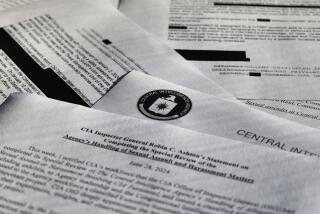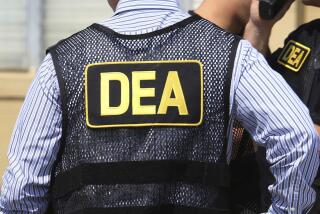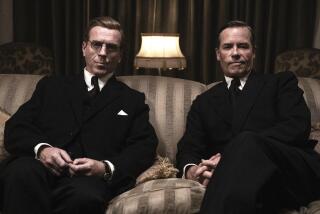For Love or Money
WASHINGTON — The CIA has flushed what it says is another mole for Moscow inside the agency, but it is becoming increasingly clear that, as in the case of Aldrich H. Ames, the agency failed for a considerable time to hear the sound of burrowing within its Langley, Va., headquarters.
Harold J. Nicholson is the highest-ranking CIA officer ever to be charged with betraying his country. If found guilty, in the pantheon of traitors, in terms of damage done, he would rank just below Ames and Edward Lee Howard, a CIA man who sold secrets to the KGB and escaped to Moscow in 1985.
For the Central Intelligence Agency, the disclosure of another mole was about the last thing it needed, coming as it did so soon after the Ames case and on top of unproved accusations that the agency was somehow responsible for the crack-cocaine epidemic in the inner cities. So John M. Deutch, the agency’s director, responded in time-honored Washington fashion when the story broke. He held a news conference and engaged in a furious effort at spin control.
With FBI director Louis J. Freeh, who has troubles of his own, at his side, Deutch sounded almost celebratory as he talked about the arrest of the $73,000-a-year CIA officer. “This arrest,” he said, “demonstrates that the counterintelligence reforms that have been put into place in the wake of Aldrich Ames have taken hold and . . . have led to our success in catching the spy Nicholson.”
But did the tripwires and mole-alert systems that the CIA installed after the Ames debacle indeed unearth Nicholson? Or did he simply flunk a lie-detector test last year, leading the agency’s counterintelligence sleuths to take a closer look at the man they now claim was selling secrets to the SVR, the successor to the KGB? Nicholson, a 16-year veteran of the spy agency, turned 46 the day after his arrest at Dulles Airport on Nov. 16 as he was about to board a plane on the first leg of a journey to Switzerland, where, the government says, he was planning to meet again with his Russian spymasters.
Born in Woodburn, Ore., the son of an Air Force officer, Nicholson has a master’s degree and was an Army captain working in intelligence before he joined the CIA in 1980. On a fast track in the agency’s clandestine arm, the Directorate of Operations, Nicholson spied in Manila, Bangkok and Tokyo. He did well, because, in 1990, he was named chief of station in Romania. Very few CIA officers make it as high as station chief.
Two years later, he was sent to Kuala Lumpur, Malaysia, as deputy station chief. While there, he was assigned to meet with a Russian intelligence officer to try to recruit him to work for the CIA. Instead, the CIA believes, the SVR operative recruited Nicholson--or the CIA man volunteered to spy for Moscow. Since it was Nicholson’s job to meet with the Russian, he had perfect cover. Ames had the same official assignment to recruit Russians when he began passing CIA secrets to the KGB in 1985. It was in Malaysia in 1994, when Nicholson’s marriage broke up, that he started selling information to Moscow, investigators say, although they cannot rule out the possibility that the spying began earlier, perhaps in Romania.
Beginning in 1994, the government says, Nicholson received some $180,000 for his treachery, openly wiring thousands of dollars to his bank accounts in the United States. It was chicken feed compared with the $4.6 million that Ames was paid or promised by the KGB and its successor.
From 1994 to July 1996, Nicholson was assigned to the “Farm,” near Williamsburg, Va., the guarded installation where the agency trains its future spies. But, on leave time, he traveled to London, New Delhi, Bangkok, Kuala Lumpur and Singapore to meet with the Russians. That should have raised an eyebrow or two in Langley, since travel is expensive and Nicholson had three children to support on his $73,000-a-year salary.
After the Ames debacle, the CIA did instituted reforms designed to ferret out any moles in its ranks. Lie detector, or polygraph tests, are sometimes to be given at random, instead of at regular five-year intervals; all CIA employees, not only senior managers as before, are required to file annual financial disclosure statements, and an FBI agent is in charge of counterespionage in the CIA’s Counterintelligence Center. Other tripwires designed to catch moles were put into place; if employees travel a lot, as Nicholson did, their names are supposed to go on a watch list.
Despite the insistence by Deutch and CIA officials that the various post-Ames reforms produced the signals that snared Nicholson, no evidence has been made public, so far, that the CIA picked up on Nicholson’s unexplained income or his globe-trotting. Then, in October 1995, Nicholson flunked two routine polygraph tests. He failed a third polygraph in December.
When reporters pressed Deutch at the joint news conference to say what triggered the investigation, he sought to downplay the importance of the lie-detector tests. “The polygraph results were one thread, one important thread of a number of strands that led to the identification and the bringing of this person to justice.” Well, he was asked, did the analysis of the records, the tripwires, begin before the polygraph tests?
Deutch wasn’t sure. He conferred for a moment with Freeh, then fuzzed his answer. “The analysis of these different variables was taking place simultaneously,” he replied. Apparently, the CIA did not move to call in the FBI until late last year or the beginning of this year, because the FBI did not open its investigation of Nicholson until early in 1996. Robert M. Bryant, the head of the FBI’s national-security division, was quoted by the Associated Press as saying that it was not until earlier this year that the FBI discovered the first money that Nicholson had wired home--a $12,000 transfer from Kuala Lumpur to a savings account in Oregon--on June 30, 1994, one day after his last meeting with a Russian spy in the Malaysian capital.
So much for the tripwires. Moreover, Deutch’s effort to portray the CIA as having known about Nicholson early on has created something of a dilemma for the agency. Under Section 811 of the 1995 Intelligence Authorization Act, the CIA is required by law to provide immediate notification to the FBI whenever there are indications that a mole has passed classified information to a foreign power.
“If they [the CIA] knew,” said one FBI source, “they had an obligation to report this. They were a little less than expeditious. The question is, when did the agency know?”
Despite Deutch’s efforts at spin control, the CIA may not really have faced up to the fact that it had another mole until Dec. 4, almost a year ago, when Nicholson started taking deep breaths in an apparent attempt to beat the machine on this third polygraph test. He was warned to stop. The examiners concluded, as they had in October, that he showed deception when asked if he was hiding unauthorized contacts with a foreign intelligence service.
Nicholson, prosecutors say, gave away the identities and dossiers of the young CIA officers he trained at the Farm. That meant the Russians would know who they were when they turned up undercover in various overseas posts. He is said to have passed along to the SVR a debriefing of Ames, and the names of seven American businessmen in Moscow who were providing information to the CIA.
The damage assessment, even if Nicholson cooperates, may take weeks, months, even years. Ames betrayed 10 Soviets working for the CIA, causing their execution. The CIA is partly comforted by the fact that there is no indication in this latest case, as Deutch put it, “that any CIA or FBI assets were killed as a result of Nicholson’s spying.” Although Nicholson was reckless, storing secret documents for the Russians in his computer, just as Ames did, he was a less conspicuous spender. Ames had a half-a-million-dollar home and drove a maroon Jaguar into CIA headquarters every day. Nicholson lived in a modest, $154,000 townhouse in the Virginia suburbs and drove a Chevrolet Lumina Sports Van. But even a low-budget mole can cause a horrendous amount of damage to a secret intelligence agency.
“The morale in the agency,” said Deutch, “is not great.”
More to Read
Sign up for Essential California
The most important California stories and recommendations in your inbox every morning.
You may occasionally receive promotional content from the Los Angeles Times.










